 I am sure it will come as no surprise to anyone for me to say that the vast majority of popular songs are love songs. And although this fact may surprise no one at all--indeed, may be a painfully banal observation--no one, to my knowledge, discusses it. Indeed, it is one of those "obvious" facts of our daily lives that is rarely, if ever, discussed. I'm sure we've heard it said a thousand times, "it is a fundamental desire for human beings to love and to want to be loved," but the insight is no more startling or profound or meaningful, as a simple declarative sentence, than "the sky is blue." For scholars who approach popular music from a sociologist's perspective, such as Simon Frith, the fact that the bulk of popular songs are love songs "is more than an interesting statistic; it is a centrally important aspect of how pop music is used" ("Towards an Aesthetic of Popular Music," in Music and Society, Cambridge University Press, 1987, p. 141). For Simon Frith, it is one of the social functions of popular music "to give us a way of managing the relationship between our public and private emotional lives." Why are love songs so important to us? Frith asks.
I am sure it will come as no surprise to anyone for me to say that the vast majority of popular songs are love songs. And although this fact may surprise no one at all--indeed, may be a painfully banal observation--no one, to my knowledge, discusses it. Indeed, it is one of those "obvious" facts of our daily lives that is rarely, if ever, discussed. I'm sure we've heard it said a thousand times, "it is a fundamental desire for human beings to love and to want to be loved," but the insight is no more startling or profound or meaningful, as a simple declarative sentence, than "the sky is blue." For scholars who approach popular music from a sociologist's perspective, such as Simon Frith, the fact that the bulk of popular songs are love songs "is more than an interesting statistic; it is a centrally important aspect of how pop music is used" ("Towards an Aesthetic of Popular Music," in Music and Society, Cambridge University Press, 1987, p. 141). For Simon Frith, it is one of the social functions of popular music "to give us a way of managing the relationship between our public and private emotional lives." Why are love songs so important to us? Frith asks.
Because people need them to give shape and voice to emotions that otherwise cannot be expressed without embarrassment or incoherence. Love songs are a way of giving emotional intensity to the sorts of intimate things we say to each other (and to ourselves) in words that are, in themselves, quite flat. It is a peculiarity of everyday language that our most fraught and revealing declarations of feeling have to use phrases--'I love/hate you', 'Help me!', 'I'm angry/scared'--which are boring and banal; and so our culture has a supply of a million pop songs, which say these things for us in numerous interesting and involving ways. (141)
There's another way to explain why our culture has a million songs about love, though, and it has been expressed by a prominent musician and songwriter, jazz sage Mose Allison. During an interview with Joel Dorn (cited in the liner notes to Allison Wonderland: The Mose Allison Anthology, Atlantic, 1994) Allison said this, which I hope we'll ponder the next time we hear one of those "silly" love songs on the radio:
A prominent white educator was studying the culture of the Hopi, a desert-dwelling Native American tribe of the Southwest. He found it strange that almost all Hopi music was about water and asked one of the musicians why. He explained that so much of their music was about water because that was what they had the least of. And then he told the white man, "Most of your music is about love."
Tuesday, May 20, 2008
Silly Love Songs
Monday, May 19, 2008
Death Valley Days
 According to a report published this afternoon on the Los Angeles Times website, early tomorrow morning (Tuesday), Inyo County Sheriff’s investigators, accompanied by forensic scientists, will begin lugging portable ground-penetrating radar, magnetometers, shovels, and other excavating tools up to the Barker Ranch at the edge of Death Valley on a mission to confirm or deny speculation that there may be graves at the ranch, used in 1969 as a secluded hideout by Charles Manson and his so-called “Family.” The excavation at the Barker Ranch, located at the southern end of Death Valley National Park—in terrain so formidable that it can only be reached by 4-wheel drive vehicles—is expected to continue through Thursday.
According to a report published this afternoon on the Los Angeles Times website, early tomorrow morning (Tuesday), Inyo County Sheriff’s investigators, accompanied by forensic scientists, will begin lugging portable ground-penetrating radar, magnetometers, shovels, and other excavating tools up to the Barker Ranch at the edge of Death Valley on a mission to confirm or deny speculation that there may be graves at the ranch, used in 1969 as a secluded hideout by Charles Manson and his so-called “Family.” The excavation at the Barker Ranch, located at the southern end of Death Valley National Park—in terrain so formidable that it can only be reached by 4-wheel drive vehicles—is expected to continue through Thursday.
I look forward to the findings of this intriguing archaeological/forensic research mission, as it has been rumored for almost forty years that the Manson Family committed murders that were recorded on film (or video, depending on the specific version of the rumor). I invite readers to read David Kerekes and David Slater’s book, Killing For Culture (Creation Books, 1994) for further information on the putative Barker Ranch murders. Kerekes and Slater aver that the idea of the Manson family making “snuff” films dates back to Ed Sanders’ book on Charles Manson, The Family (first published by E.P. Dutton, 1971). It was Ed Sanders, in this book, who coined the term “snuff” to describe the content of these elusive films purportedly containing scenes of actual murder. Kerekes and Slater write:
These “whispers” [of snuff films] date back to Ed Sanders’ book, The Family. Here, Sanders states that Family members stole an NBC-TV wagon loaded with film equipment sometime during the Summer of 1969. The truck was subsequently dumped and most of the film given away, but Manson took one of the NBC cameras with him to Death Valley in September [1969]. The Family were also in possession of three Super-8 cameras. It is alleged that they shot porn-movies and, determines Sanders, “the Barker Ranch chop-stab dance, where they [the Family] danced in a circle, then pretended to go into frenzies—attacking trees, rocks and one another with knives.” He adds, “God knows what else they shot with their stolen NBC camera”.... Speaking with an anonymous one-time member of the Family, Sanders learns of a “short movie depicting a female victim dead on a beach” (Killing For Culture, p. 223).
According to the Los Angeles Times report, locals in the area predict the investigators will turn up nothing but ancient Indian graves. Others, however, say the situation is more problematic in that some California state park rangers claim that if indeed human remains are discovered at the Barker Ranch, they may be connected to an unrelated Death Valley mystery from 1996, the mysterious disappearance of four German tourists.
We shall see.
Something's Up My Sleeve
Yesterday’s blog on the art of rock art prompted me to think about the art of the album cover—the vinyl LP album cover specifically. I say “cover,” but is that the proper nomenclature? Why not “jacket,” or “sleeve”? With the advent of the compact disc jewel case, the material aspect of a vinyl LP’s “jacket,” “cover,” “sleeve,” or “wrapper” is no longer applicable, although a recent development in the music industry has been to reissue albums on compact disc in CD-sized sleeves that duplicate the “original art work" of the LP. The restoration of the original album art reflects a desire, I suppose, for presence, an attempt, writes John Corbett, “to stitch the cut that separates seeing from hearing in the contemporary listening scenario” (Extended Play: Sounding Off from John Cage to Dr. Funkenstein, Duke University Press, 1994, p. 39). For Corbett, the album cover is an "attempt to reconstitute the image of the disembodied voice" (p. 39) to recorded sound.
Having thought about the issue the past twenty-four hours, and having spent some time browsing through my LP collection, I here present my Top 11 favorite album covers—and why eleven? Because I can do as I please; I don't have to limit myself to ten. Why are they my favorites? Because they enchant me without my knowing exactly why: as Roland Barthes observed, "such ignorance is the very nature of fascination" (Roland Barthes by Roland Barthes, Hill and Wang, 1977, p. 3). Do my selections belie my age? Probably, but I would hope that others find my choices as inherently fascinating as I do.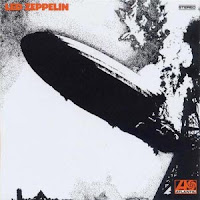
1. Led Zeppelin—Led Zeppelin (Atlantic, 1969); designer, George Hardie.
2. Steppenwolf—Steppenwolf (Dunhill, 1968); designer: Gary Burden; photographer: Tom Gundelfinger.
3. Elvis Presley—Elvis Presley (RCA, 1956); designer: Colonel Tom Parker; photographer: Popsie [William S. Randolph].
4. London Calling—The Clash (Epic, 1979); designer: Ray Lowry; photographer: Pennie Smith.
5. News of the World—Queen (Elektra, 1977); designer: Roger; painting: Frank Kelly Freas (1953).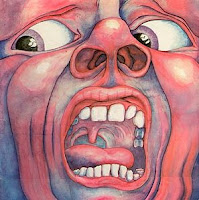
6. In the Court of the Crimson King—King Crimson (Atlantic, 1969); painting: Barry Godber.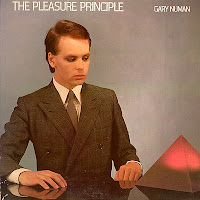
7. The Pleasure Principle—Gary Numan (Atco, 1979); designer: Malti Kidia; photographer: Geoff Howes.
8. Electric Warrior—T. Rex (Warner Brothers, 1971); designer: Hipgnosis.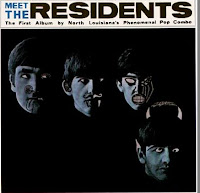
9. Meet the Residents—The Residents (Ralph, 1974); designer: Porno/Graphics; photographer: Robert Freeman.
10. Dark Continent—Wall of Voodoo (I.R.S., 1981); designer: Philip Culp; photographer: Scott Lindgren.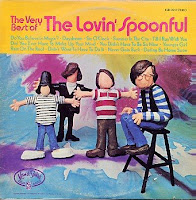
11. The Very Best of the Lovin’ Spooful—The Lovin’ Spoonful (Kama Sutra, 1970); sculpture: Ollie Alpert.
Sunday, May 18, 2008
Art of Rock
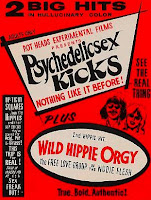 At Bonhams New York this past Wednesday, May 14, The Peter Golding Collection of Rock & Roll Art fetched close to $795,000, according to a spokesman for the auction house. While many of the pieces were original works of art, some of the items included preliminary drawings and sketches for album covers and concert posters. The Peter Golding collection represents about forty years of collecting such work; Golding is the British designer of the first stretch jeans. Go here for a closer look at the 164 lots offered at the auction. The auction's top seller was an 48"x36" acrylic on canvas by the late Rick Griffin--considered by some to be psychedelia's grand master--for the Grateful Dead's 1990 "Without a Net" European tour, which sold for $114,000; go here to see the piece.
At Bonhams New York this past Wednesday, May 14, The Peter Golding Collection of Rock & Roll Art fetched close to $795,000, according to a spokesman for the auction house. While many of the pieces were original works of art, some of the items included preliminary drawings and sketches for album covers and concert posters. The Peter Golding collection represents about forty years of collecting such work; Golding is the British designer of the first stretch jeans. Go here for a closer look at the 164 lots offered at the auction. The auction's top seller was an 48"x36" acrylic on canvas by the late Rick Griffin--considered by some to be psychedelia's grand master--for the Grateful Dead's 1990 "Without a Net" European tour, which sold for $114,000; go here to see the piece.
One of the more interesting items for sale was an exhibitor's brochure for the movies Psychedelic Sex Kicks and Wild Hippie Orgy, presented by "Pot Heads Experimental Films." The brochure's cover promises "2 Big Hits" in "Hullucinary Color" [sic]. If you always wanted to own the item, you still have a chance--although the brochure was estimated to go between $150-250, it didn't sell. The films boast scenes in which "Up-tight squares join the hippies and their hip chicks...this trip is for real!"
By Hook or by Crook
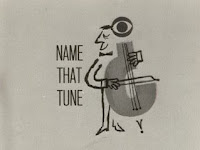 What’s the difference between a hook and a ditty? Available definitions don’t offer much help, I’ve discovered. The following definitions are available from answers.com:
What’s the difference between a hook and a ditty? Available definitions don’t offer much help, I’ve discovered. The following definitions are available from answers.com:
Hook (n.):
1. a. A curved or sharply bent device, usually of metal, used to catch, drag, suspend, or fasten something else.
b. A fishhook.
2. Something shaped like a hook, especially:
a. A curved or barbed plant or animal part.
b. A short angled or curved line on a letter.
c. A sickle.
3. a. A sharp bend or curve, as in a river.
b. A point or spit of land with a sharply curved end.
4. A means of catching or ensnaring; a trap.
5. Slang. a. A means of attracting interest or attention; an enticement: a sales hook.
b. Music. A catchy motif or refrain: “sugary hard rock melodies [and] ear candy hooks” (Boston Globe).
Ditty (n., pl. –ties):
A simple song.
[Middle English dite, a literary composition, from Old French dite, from Latin dictātum, thing dictated, from neuter past participle of dictāre, to dictate.]
So apparently the word “ditty” refers to a complete song, while “hook” refers to a rhythmic figure or melodic line, that is, a specific element of a song. So is a ditty (song) necessarily composed of more than one hook, or just one? To me, anyway, the origin of the word “ditty” from the Latin dictātum (“thing dictated”) suggests that a ditty is easy to remember (“simple”). Information theory would then tell us that a ditty has a low probability of being transmitted incorrectly (“distorted”), another way of saying it is easily remembered: how many times did you have to hear “Happy Birthday” before you remembered the whole song? Once? The popular TV game show Name That Tune is premised precisely on this insight, that one needs only a few notes in order to have total recall of a song. (I best remember the version of the show in the Seventies hosted by Tom Kennedy, but historically there have been several incarnations of Name That Tune, beginning in the 1950s.)
Are the best pop songs, then, no more than ditties? According to Gary Burns, in “A typology of ‘hooks’ in popular records” [Popular Music 6:1 (Jan., 1987) p. 1], the word hook
connotes being caught or trapped, as when a fish is hooked, and also addiction, as when one is hooked on a drug. These connotations, together with the idea of repetition, are captured in the Songwriter’s Market definition of hook: ‘A memorable “catch” phrase or melody line which is repeated in a song’ (Kuroff 1982, p. 397. Bennett (1983) defines hook as an ‘attention grabber’ (pp. 30, 41).
Music critic Lester Bangs was never comfortable with the multiple connotations of hook as “catchy,” meaning hook as that which catches or ensnares the prey, is addictive, and is seductive and appealing as candy. He wrote:
Listen, I hate hooks. The first time I saw the word “hook” was in a review of a Shocking Blue album in Rolling Stone in 1969. The author had evidently discovered that songwriters sometimes used it and now informed us that the bass riff was the almighty “hook” in their hit “Venus,” that one irresistible little melodic or rhythmic twist that’ll keep you just coming back and back and back and buy and buy and buy. (“Every Song a Hooker,” in Mainlines, Blood Feasts, and Bad Taste: A Lester Bangs Reader, Anchor Books, 2003, pp. 351-52)
Freud argued that repetition is pleasurable because we associate it with the pleasure of the mother’s breast (or bottle) from which we nursed (sucked, in the sense of reiterated action) as infants. Whether one believes this argument is irrelevant, because in fact the most successful pop songs (measured in terms of economic success) prove the point anyway, with their relentless repetition--reiteration--of melodic lines and rhythmic figures, a practice justified in order to make a song "suitable for dancing".
Lester Bangs cited “Leader of the Pack” by the Shangri-Las as a positive example of a song with hooks, while Kim Carnes’ “Bette Davis Eyes” is a negative example (an instance of music business "cynicism"). I might cite “My Guy” by Mary Wells as a positive example, or The Temptations' "Just My Imagination (Running Away With Me)," the type of song that if I hear it early in the day I hear it the rest of the day (in a good way). But if Bachman-Turner Overdrive’s “Takin’ Care of Business” comes on the radio, the radio goes off--as fast as my synapses can fire.
For further reading:
Lick
Riff
Theme
Melody
Ostinato
Saturday, May 17, 2008
The Mad Man
 Will Elder (1921-2008), among the first cartoonists whose work appeared in that long-running magazine satirizing American popular culture, Mad, at its inception in 1952, has died at age 86 of Parkinson’s disease. Among Elder's other creations for the venerable magazine was the figure of the career criminal named "Mole" who was always tunneling into disaster. And in issue #27 (April 1956) the magazine offered for mail-in purchase a 5x7 black & white portrait of the “What, Me Worry?” kid, first drawn by Elder. He thus was the first artist to draw that magazine's iconic kid with the huge grin, although a couple of issues later (#30), artist Norman Mingo drew a color rendition, and "Alfred E. Neuman" was born. The original black & white portrait by Elder is now a valuable collector’s item, as it was offered for sale only in a couple of issues before Mingo's version replaced it.
Will Elder (1921-2008), among the first cartoonists whose work appeared in that long-running magazine satirizing American popular culture, Mad, at its inception in 1952, has died at age 86 of Parkinson’s disease. Among Elder's other creations for the venerable magazine was the figure of the career criminal named "Mole" who was always tunneling into disaster. And in issue #27 (April 1956) the magazine offered for mail-in purchase a 5x7 black & white portrait of the “What, Me Worry?” kid, first drawn by Elder. He thus was the first artist to draw that magazine's iconic kid with the huge grin, although a couple of issues later (#30), artist Norman Mingo drew a color rendition, and "Alfred E. Neuman" was born. The original black & white portrait by Elder is now a valuable collector’s item, as it was offered for sale only in a couple of issues before Mingo's version replaced it.
An obituary can be found here, and an interesting interview over here. Daniel Clowes’ book, Will Elder: The Mad Playboy of Art, is widely available on the web, as is Elder's Chicken Fat, a collection of drawings, sketches, and cartoons. Among Elder's other famous creations is "Little Annie Fanny," the comic strip featuring a buxom blond that appeared in Playboy magazine; collections of these 'toons are also available in book form.
I suspect that rather than mourn his passing, Elder would prefer us to inject some humor into our day today--inject some humor "in a jugular vein."
Friday, May 16, 2008
Lumpy Pandemonium Ballet
 At the beginning of this year I embarked on a peculiar, perhaps grossly self-indulgent experiment of trying to listen to all the rock and R&B albums released in the year of 1968--forty years ago--in the order, as best as I could determine, in which they were released. Why 1968? Because it was the year I seriously began to collect albums. I cannot claim that the following list of albums is exhaustive; rather, it consists of those albums I either had or I could easily get my hands on (eBay therefore came in handy on occasion). As might be expected, the experiment prompted me to fill in some gaps in my collection. I sat down over my Christmas break and compiled as comprehensive a list as I could make, then determined which albums I already owned (on vinyl LP or compact disc) and which I would need to acquire. As it turns out, I had a good number of them, although I purchased a few on CD because I wanted the liner notes and bonus tracks.
At the beginning of this year I embarked on a peculiar, perhaps grossly self-indulgent experiment of trying to listen to all the rock and R&B albums released in the year of 1968--forty years ago--in the order, as best as I could determine, in which they were released. Why 1968? Because it was the year I seriously began to collect albums. I cannot claim that the following list of albums is exhaustive; rather, it consists of those albums I either had or I could easily get my hands on (eBay therefore came in handy on occasion). As might be expected, the experiment prompted me to fill in some gaps in my collection. I sat down over my Christmas break and compiled as comprehensive a list as I could make, then determined which albums I already owned (on vinyl LP or compact disc) and which I would need to acquire. As it turns out, I had a good number of them, although I purchased a few on CD because I wanted the liner notes and bonus tracks.
I must emphasize that this list is rather idiosyncratic, neither a "classic rock" list nor an attempt to listen to every pop album released that year. What follows is the order in which I have listened to the albums (with one exception, as indicated). This week, for instance, I have been listening to Frank Zappa's album Lumpy Gravy, which so far as I was able to determine, was released on LP on May 13, 1968--forty years ago this week. Next week I'll listen to Spooky Tooth's It's All About. Predictably, during the course of compiling this list I found that my memory was faulty: I mistakenly had albums released later in the year in the record bins earlier in the year (and vice versa). Happily, I must also admit to having discovered a few albums I'd overlooked all those years ago that have now become my favorites--Harry Nilsson's Aerial Ballet, for instance. In fact, I liked it so much I was motivated to acquire his previous album, Pandemonium Shadow Show (1967), which I learned was one of John Lennon's favorites and which has become, four decades late(r), one of mine. While I'd always very much liked Nilsson, I was most familiar with his later albums; I am delighted to have finally given these albums the careful listen they so richly deserve.
If any readers have the inclination to correct the information below, or suggest I acquire titles that I've so far overlooked, please don't hesitate to contact me. I'll periodically update the list and correct it, and of course add to it in future blogs. At the end of the month, if I remember, I'll post my June listening schedule. Consider it the aural equivalent of what book stores call a summer reading program. If there is a certain "classic" album missing from the following list, then you can be reasonably certain that it wasn't yet released by the end of May 1968 (e. g., Pink Floyd's A Saucerful of Secrets, released in June, or The Byrds' Sweetheart of the Rodeo, released in July).
Please note that some live albums, released two or three years after their original recording (or in some cases, decades later), have been reinserted into the proper sequence to reflect the time they were recorded. These titles are indicated in brackets [ ] after the group's name. Dates reflect US release unless indicated otherwise. Finally, some release dates were determined by the album's catalog number, admittedly not the best way to determine the release date, but a reasonably good indicator nonetheless.
January
Elvis Presley, Elvis’ Gold Records, Volume 4 - 1/2
The Byrds, The Notorious Byrd Brothers- 1/3
The Kinks, Live at Kelvin Hall - 1/12
The Bee Gees, Horizontal
Autosalvage, Autosalvage
Blue Cheer, Vincebus Eruptum
Steppenwolf, Steppenwolf
The Electric Prunes, Mass in F Minor
Canned Heat, Boogie with Canned Heat - 1/21
Aretha Franklin, Lady Soul - 1/22
Spirit, Spirit - 1/22
Van Dyke Parks, Song Cycle - 1/29
February
Mason Williams, The Mason Williams Phonograph Record
Blood, Sweat & Tears, Child is Father to the Man
Dr. John the Night Tripper, Gris-gris
Iron Butterfly, Heavy
Tomorrow, Tomorrow
Graham Gouldman, The Graham Gouldman Thing
The Rascals, Once Upon a Dream - 2/19
Otis Redding, The Dock of the Bay - 2/23
Fleetwood Mac, Fleetwood Mac - 2/24
March
Laura Nyro, Eli and the Thirteenth Confession - 3/3
The United States of America, The United States of America - 3/6
The Mothers of Invention, We're Only In It For the Money
Vanilla Fudge, The Beat Goes On
Cream, [Live Cream] [4/70]
The Move, Move [listened to out-of-sequence, just recently]
The Electric Flag, A Long Time Comin’
Joni Mitchell, Song For a Seagull
Incredible String Band, The Hangman’s Beautiful Daughter
The Association, Birthday
The Yardbirds, [Live Yardbirds: Featuring Jimmy Page] - 3/30 [5/71]
April
Simon & Garfunkel, Bookends - 4/3
Moby Grape, Wow/Grape Jam - 4/3
The Zombies, Odessey & Oracle - 4/9 [UK date]
Janis Joplin w/ Big Brother and the Holding Company, [Live at the Winterland ’68, 4/12-13] [1998]
Jimi Hendrix Experience, Smash Hits [UK date]
The Rose Garden, The Rose Garden
Scott Walker, Scott 2
The Monkees, The Birds, The Bees & The Monkees - 4/22
Stephen Stills, [Just Roll Tape, 4/26] [2007]
Sly & The Family Stone, Dance to the Music - 4/27
Scott Walker, Scott 2 - 4/27
The Mamas & Papas, The Papas & The Mamas - 4/29
May
Jefferson Airplane, [Live at the Fillmore East, 5/3-4] [1998]
The Collectors, The Collectors
Quicksilver Messenger Service, Quicksilver Messenger Service
Frank Zappa, Lumpy Gravy - 5/13
Spooky Tooth, It’s All About
The Small Faces, Ogden’s Nut Gone Flake - 5/24
Max Frost And The Troopers, Shape of Things to Come 5/29
[Faux band from AIP’s Wild in the Streets, released 5/29/68]
Again, corrections and/or emendations are welcome (please provide source of your information if you find my dating faulty). I'll try to post June's listening schedule before the end of the month.
List emended 8 September 2008
Thursday, May 15, 2008
Bozo Dionysus
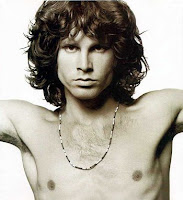 For what perverse reason do “classic rock” radio stations always play the Doors’ “Riders on the Storm” whenever it’s raining? I awoke to find it raining here this morning, and sure enough, as I sat down to check my email after having turned on the radio, like clockwork the DJ played “Riders on the Storm.” The song is instantly recognizable, of course: the opening crash of thunder, the tinkling of the keyboard imitating falling raindrops, and, inevitably, the sinister lyric about the “killer on the road” whose “brain is squirmin’ like a toad.” As poetry it is of a badness not to be believed; there is no group in rock history that so insistently challenges the issue of whether musical quality and canonical status go hand in hand as do the Doors.
For what perverse reason do “classic rock” radio stations always play the Doors’ “Riders on the Storm” whenever it’s raining? I awoke to find it raining here this morning, and sure enough, as I sat down to check my email after having turned on the radio, like clockwork the DJ played “Riders on the Storm.” The song is instantly recognizable, of course: the opening crash of thunder, the tinkling of the keyboard imitating falling raindrops, and, inevitably, the sinister lyric about the “killer on the road” whose “brain is squirmin’ like a toad.” As poetry it is of a badness not to be believed; there is no group in rock history that so insistently challenges the issue of whether musical quality and canonical status go hand in hand as do the Doors.
I can think of no other band of the so-called “classic rock” era so inevitable, and so dubious, as the Doors. Neither could the incomparable Lester Bangs, certainly the wittiest and most iconoclastic of American rock critics. His temperament was such that he couldn’t tolerate the solecism of the rock star, and if ever there were the sort of rock star who excelled at impropriety and obnoxiousness, it was Jim Morrison, characterized by Bangs in an essay published in 1981 as “Bozo Dionysus.” Bangs’ essay, “Jim Morrison: Bozo Dionysus a Decade Later,” was written in response to his having read Jerry Hopkins’ and Danny Sugerman’s Morrison biography, No One Here Gets Out Alive. Having read the book, Bangs concluded that Morrison “was apparently a nigh compleat asshole from the instant he popped out of the womb until he died in the bathtub in Paris....,” as illustrated by incidents such as when he was a kid rubbing dog shit in his little brother’s face, or his later, pathetic, “cock-flashing incident” in Miami in 1969, an action, Bangs observed, that was motivated out of “the same desperation that drives millions of far less celebrated alcoholics.”
What makes the Doors so inevitable as rain? Although he was writing early in 1981 in the context of a Doors resurgence (repeated a decade later with the release of Oliver Stone’s film), I think Lester Bangs is correct when he observes:
... can you imagine being a teenager in the 1980s and having absolutely no culture you could call your own? Because that’s what it finally comes down to, that and the further point which might as well be admitted, that you can deny it all you want but almost none of the groups that have been offered to the public the past few years begin to compare with the best from the Sixties. And this is not just Sixties nostalgia—it’s a simple matter of listening to them side by side and noting the relative lack of passion, expansiveness, and commitment in even the best of today’s groups. (Main Lines, Blood Feasts, and Bad Taste: A Lester Bangs Reader, p. 215)
Bangs has a point, and I can provide anecdotal evidence to substantiate it. Several semesters after I started teaching college twenty-seven years ago, I had a student in my class who had the distinction of having been born at the Woodstock festival in 1969—there were two babies born at Woodstock, and he was one of them. (Not that it meant anything to him. His stepfather told me this, not the kid—at the time—to whom I’m referring.) He was a punk rocker with an aggressive, “fuck you” attitude—died hair, safety pins in the ears, the whole apparatus. He dressed like a Hell’s Angel—motorcycle boots, leather pants and jacket, always a black T-shirt with an image or writing on it. The overall effect was comic, however, because of his age—because he was so young, he was a sort of ludicrous pastiche of a Hell’s Angel, especially when he wore a bandanna, and became a sort of Kewpie doll version of a Hell's Angel. He liked to hang out but didn’t have very much money, so he used to get the owner of the record store to play albums for him, and he would pass judgment based on only a couple of listens. He liked the Sex Pistols and the early Clash, and he liked American groups such as The Ramones and Black Flag. Most importantly, he loved Iggy Pop. He didn’t like later Clash albums such as Sandinista! (1980), because while he claimed to be apolitical, he was actually conservative; he didn’t like the Left-leaning, liberal posturing of that album. And he despised Combat Rock (1982), saying the Clash were sell-outs.
He had very little to say about Sixties groups (with the exception of The Stooges, of course), but he did, though, express great love for the music of the Doors. If you stop to think about it, he was growing in his mother’s womb when Jim Morrison drunkenly flashed his flaccid cock on stage in Miami in March 1969; he wasn’t yet two years old when Morrison died. He would have been around eleven years old when Hopkins’ and Sugerman’s Morrison biography was published and became a best-seller. And he would have been twenty-one when Oliver Stone’s The Doors was released, and I’m very sure the depiction of Jim Morrison in that film made a huge impression on him, as it did others of his generation.
Can you imagine being a teenager in the 1980s and having absolutely no culture you could call your own? Lester Bangs asked, rhetorically, and it was absolutely the right question to ask in order to explain why the Doors had a resurgence beginning in the 1980s. To answer the question is to understand why Iggy Pop is so beloved by that same generation of teenagers. “Surely he [Morrison] was one father of New Wave, as transmitted through Iggy and Patti Smith,” Bangs observed, although he goes on to say, “but they have proven to be in greater or lesser degree Bozos themselves” (219).
Why the appellation “Bozo Dionysus”? I think what Bangs is getting at is the disjunction between what Morrison sought to do and what he actually did: “Jim Morrison had not set out, initially, to be a clown,” but that’s what he became when his literary ambitions were frustrated. By the time of infamous flashing event in Miami, he was too drunk on stage to do anything but do something pathetic, which he, sure as rain, did. He had become redundant by the time L. A. Woman was released in 1971 (for some, however, he had nothing left to say after the Doors’ first album) and like many failed poets, found solace in booze. Perhaps he sought to find a literary renewal in Paris, but all he found was more drugs and, inevitably, alcohol.
The irony is that the song for which the Doors perhaps are most famous, “Light My Fire,” was written not by Morrison but by Robby Krieger (unless you count the lyrics, of course), but I think Lester Bangs is right when he claims that the one great song Morrison had in him was “People Are Strange”:
People are strange when you’re a stranger
Faces look ugly when you’re alone
Women seem wicked when you’re unwanted
Streets are uneven when you’re down
The song’s evoking of a subjective disorientation and dislocation was the effect Morrison frequently sought, but seldom achieved; the song happens to be on what seems to me to be the best, as in listenable, Doors album, Strange Days (1967). Later albums, such as The Soft Parade (1969), fail, primarily because the band was by then engaged in self-parody, and no one can do parody any better than the artist does of himself: think of the “When I was back there in seminary school” and “You cannot petition the Lord with prayer!” rant that begins the muddled “The Soft Parade”—self-parody at its best, and therefore an embarrassment for the listener.
I again refer to Lester Bangs, who claimed that, like it or not, Jim Morrison was one of the fathers of contemporary rock. In Lacanian, that is, psychoanalytic terms, his claim can be understood as saying that Morrison's function is that of the objet petit a, the lure around which the drive circulates, the absence around which the rock community explains its history to itself. In other words, if Jim Morrison didn't exist, we would have to invent him.
Wednesday, May 14, 2008
Robert Rauschenberg, 1925-2008: Artist of the Abject

Although his work is derided by many critics, Robert Rauschenberg, who died this past Monday, May 12 at the age of 82, eventually may become known as one of the most important American artists of the twentieth century. Primarily known for his “combines”— combinations of three-dimensional objects and paint—for me, Rauschenberg is best remembered as an artist of the abject. Abject commonly means “excessively humble,” or sometimes “contemptible,” but in this case I'm also using "abject" to refer to common, everyday waste, thrown away quotidian objects, “cast offs”—in short, “refuse.”
Perhaps his most famous work is Monogram (pictured), depicting a stuffed Angora goat standing atop a platform consisting of a collaged painting and amid objects such as a police barrier, a shoe heel, and a tennis ball. Oddly, the goat has a used automobile tire wrapped around the middle of its body. I read where Rauschenberg, raised as a Christian fundamentalist in Port Arthur, Texas, said as a child he suffered a severe emotional trauma as a result of his father killing his pet goat for food. He no doubt loved that goat, and in some sense, consciously or unconsciously, modeled his own creative method after a goat’s behavior, for after all, a goat finds everything, even the most banal refuse, interesting—and potentially edible. Rauschenberg said he would roam the streets near his studio in New York for things that he would subsequently incorporate into his art. We can therefore conceive of his entire creative output—and I mean this very seriously—as inspired by the relentlessly foraging behavior of that old, beloved goat. A goat is eclectic in its tastes; it finds everything equally interesting, even the most abject of objects.
I should mention that critic Robert Hughes finds Monogram to have an entirely different meaning, the title itself serving as a statement of personal identity. Hughes observes:
... the wonderful Monogram, the stuffed Angora goat Rauschenberg found in an office supply store on 23rd Street in the early 1950s and encircled with a car tyre. One looks at it remembering that the goat is an archetypal symbol of lust, so Monogram is the most powerful image of anal intercourse ever to emerge from the rank psychological depths of modern art. Yet it is innocent, too, and sweet, and (with its cascading ringlets) weirdly dandified: a hippy goat, a few years before the 1960s. Fifty years after its creation, it remains one of the great, complex emblems of modernity, as unforgettable (in its way) as the flank of Cézanne’s mountain, the cubist kitchen table or the wailing woman in Guernica.
While it is true that the goat is a conventional phallic symbol, it is also true that by the late 1950s, when Monogram was being created (1955-59), the most potent symbol of America—this at a time before Lady Bird Johnson’s “Beautify America” campaign a few years later—was a car tire. Used car tires were ubiquitous common objects that proliferated everywhere, like Wallace Stevens’ jars; there were, literally, mountains of them all around the country. While Hughes may well be correct in his interpretation of the meaning of Monogram, I should say that, in contrast to Hughes, for me the most famous emblem of modernity, and one of the most influential works of the twentieth century, is Marcel Duchamp’s Fountain—an inverted urinal.  Rauschenberg’s artistic works have frequently been characterized as blurring the line between art and modern life, and there is no more common emblem of modern life, as Jacques Lacan observed, than the public toilet. Hence Rauschenberg might well have understood that the definitive art work of the twentieth-century was a toilet—that is to say, an abject object.
Rauschenberg’s artistic works have frequently been characterized as blurring the line between art and modern life, and there is no more common emblem of modern life, as Jacques Lacan observed, than the public toilet. Hence Rauschenberg might well have understood that the definitive art work of the twentieth-century was a toilet—that is to say, an abject object.
So if, by chance, someday you hear the work of Rauschenberg being scorned, or perhaps the derisive observation that it impossible to determine whether his works belong in a thrift shop or an art museum, just think of the insatiable foraging activity of that miserable goat--who loved all things abject--killed for food, whose behavior became the inventive model for one of the more important artists--certainly the least pretentious--of the twentieth century.
Tuesday, May 13, 2008
Autonomobility
 In yesterday’s blog I referred to Georges Bataille’s notion of “expenditure,” exploring the implications of Bataille’s observation that human cultures engage in wasteful, non-productive expenditure, performing unacknowledged sacrifices to shared cultural values that are nonetheless ignored, degraded, or repressed. As an example of this repressed loss and wasteful expenditure, consider the roughly 43,000 deaths, referred to as “accidents,” that occur each year on American highways—unacknowledged sacrifices to the freedom of the highway, to the deeply held value Americans call the open road. According to statistics available through the National Highway Traffic Safety Administration (NHTSA), traffic deaths on national highways are remarkably consistent from year to year. According to the NHTSA, for the years 2002-2006, fatalities on American highways were as follows:
In yesterday’s blog I referred to Georges Bataille’s notion of “expenditure,” exploring the implications of Bataille’s observation that human cultures engage in wasteful, non-productive expenditure, performing unacknowledged sacrifices to shared cultural values that are nonetheless ignored, degraded, or repressed. As an example of this repressed loss and wasteful expenditure, consider the roughly 43,000 deaths, referred to as “accidents,” that occur each year on American highways—unacknowledged sacrifices to the freedom of the highway, to the deeply held value Americans call the open road. According to statistics available through the National Highway Traffic Safety Administration (NHTSA), traffic deaths on national highways are remarkably consistent from year to year. According to the NHTSA, for the years 2002-2006, fatalities on American highways were as follows:
2006: 42,642
2005: 43,510
2004: 42,836
2003: 42,884
2002: 43,005
Average for period 2002-06: 42,975
A remarkably stable statistical figure (and hence not subject to huge fluctuation—the range from highest to lowest over the five-year period listed above is only 868) Americans are content to sacrifice 43,000 people a year in order to maintain the value that Gregory Ulmer, in his article “Abject Monumentality” (Lusitania 1, 1993) describes as “the ability to go anywhere, anytime.” He goes on to say that this cultural value, to go where we want, when we want, at anytime we want, is what we
actually believe in and are willing to die for. As such, it provides the basis for coherence in the community, and is a secularized equivalent of the roughly 5,000 individuals who were sacrificed at the wedding of the Aztec leader, Moctezuma in [the fifteenth-century]. (“Abject Monumentality” 11)
Although called “traffic accidents,” these deaths are hardly anomalous. The harsh fact is, 43,000 Americans are born each year condemned to inherit an accursed share, destined to die in honor of the value that Katie Mills, in her book The Road Story and the Rebel (Southern Illinois University Press, 2006) calls the deeply held American value of “automobility,” a value that I prefer to name by the neologism autonomobility, a portmanteau containing the words “automobile,” “autonomy,” and “mobility.”
As a follow-up to yesterday’s blog, consider the deaths of popular musicians that have occurred by means of the automobile—Johnny Horton, Harry Chapin, Eddie Cochran, Marc Bolan (T. Rex)—and those whose careers were irreparably damaged because of a car crash, for instance, Carl Perkins, Gene Vincent, and Allen Collins (guitarist for Lynyrd Skynyrd) to name a few (and although she died in plane crash, Patsy Cline was earlier severely injured in a car crash, forcing her to wear a wig low on her forehead to cover the huge scar caused by her head slamming into the windshield). The picture above is a photo taken at the scene of James Dean’s fatal car crash in 1955, but one should also consider the deaths of Judy Tyler (Elvis’s co-star in Jailhouse Rock), Soledad Miranda, Princess Diana, Princess Grace (Grace Kelly), Jayne Mansfield, Lisa Lopes, Albert Camus, Jackson Pollock, Margaret Mitchell, Isadora Duncan, Sam Kinison, author David Halberstam, race car driver Dale Earnhardt, Sr., and General George S. Patton. All of these individuals, although celebrities, died in honor of the deeply held value we believe in, that of autonomobility. We should not degrade their deaths by calling them "accidents," but rather sacrifices in honor of a way of life.
Monday, May 12, 2008
Land of Toys
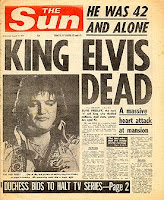 In America, if not much of the western world, the rock star is a symbol of success. Television programs are dedicated to showing the rock star’s lavish, extravagant home—his living room, his kitchen, his swimming pool, his backyard, his stables, and so on. One is presumably interested in the rock star’s special kind of conspicuous consumption--his expensive collection of automobiles, his many motorcycles, his woefully expensive hobbies--because these objects all exemplify various types of material acquisition, an external token of success. Perhaps it is time to devote a collection of rock songs to the life of the rock star, a collection of songs to be sold as a single compact disc, to be titled, perhaps, Life in the Pleasure Dome. The cover image might consist of a picture of Elvis taken in the last six months of his life.
In America, if not much of the western world, the rock star is a symbol of success. Television programs are dedicated to showing the rock star’s lavish, extravagant home—his living room, his kitchen, his swimming pool, his backyard, his stables, and so on. One is presumably interested in the rock star’s special kind of conspicuous consumption--his expensive collection of automobiles, his many motorcycles, his woefully expensive hobbies--because these objects all exemplify various types of material acquisition, an external token of success. Perhaps it is time to devote a collection of rock songs to the life of the rock star, a collection of songs to be sold as a single compact disc, to be titled, perhaps, Life in the Pleasure Dome. The cover image might consist of a picture of Elvis taken in the last six months of his life.
What is called an opulent lifestyle is in fact the wasteful expenditure of something to honor a particular set of cultural values. In the case of the rock star—actually, all stars, movie, television, and otherwise—the particular cultural values are those of extravagant, wasteful expenditure and material acquisition. The two go hand in hand. Drawing upon the theory of sacrifice as explored in Georges Bataille’s The Accursed Share (1949) and his essay, “The Notion of Expenditure” (1933), Life in the Pleasure Dome will be dedicated to celebrating the fundamental American cultural principle of wasteful expenditure as exemplified by the rock star. In the aforementioned works, Bataille explores what he calls “the principle of loss.” Bataille considers sacrifice as a form of non-productive expenditure rather than of (productive) “limited economy.” A “limited economy” attempts to maintain a zero-sum balance of profit and loss, while in contrast wasteful expenditure consists of “considerable losses.” Examples of unproductive, wasteful expenditure include:
luxury, mourning, war, cults, the construction of sumptuary monuments, games, spectacles, arts, perverse sexual activity (i.e., deflected from genital finality)—all these represent activities which...have no end beyond themselves. (118)
We can consider rock music as one of the “arts” Bataille mentions above. For Bataille these various activities constitute a group “characterized by the fact that in each case the accent is placed on a loss that must be as great as possible in order for that activity to take on its true meaning,” that is, a loss that must be both considerable and extravagant. (118)
Stated in another way: For any cultural activity to have real value, the loss must be maximized—excessive. For example, the value of diamond jewels to their owner is determined by how great is the loss in terms of financial expenditure: the more unreasonable and extravagant the expenditure, the greater the value of the diamond jewels. Bataille writes: “Jewels must not only be beautiful and dazzling (which would make the substitution of imitations possible): one sacrifices a fortune, preferring a diamond necklace; such a sacrifice is necessary for the constitution of this necklace’s fascinating character” (“Expenditure” 119). The same principle justifies the inevitable continuation of warfare: as losses, i.e., deaths and maimings, increase, a nation’s stake in a war escalates. As the deaths remorselessly accumulate, the easier it becomes to justify the war’s continuation because the stakes have grown higher. By the continuation of the war, the nation consequently becomes increasingly indebted to those who have died and have been severely maimed in battle; the acknowledgment of this mounting debt ensures that the soldiers’ sacrifices are not in vain, or have become a form of unproductive expenditure.
And yet, despite the fact that extravagant, unreasonable wasteful expenditure is an essential activity of American culture—extravagant luxuries premised on over-consumption such as the heating of huge homes and supplying fuel for gas-guzzling SUVs; millions of gallons of water to keep lawns green; sports and spectacles (e.g., “half-time” shows of “Super Bowls”); NASCAR races dedicated to the consumption of vast quantities of expensive fuel; gambling (the emblem of which is Las Vegas, dedicated to the massive consumption of coal for electric lights and slot machines); prostitution; pornography; and especially warfare—the types of wasteful expenditure (of which a just few are listed here) are consistently denied, degraded, or repressed.
The function of the CD collection Life in the Pleasure Dome is to recognize the repressed or degraded categories of loss, to honor an unacknowledged or repressed set of values that are such an essential, defining feature of American life and culture—success as wasteful expenditure, the indulgence in perverse sexual activity, and the appetite for Romantic self-destruction.
The songs can be conveniently grouped under the following thematic headings (an individual song might fit more than one grouping):
Wasteful Expenditure: The life of the rock star is celebrated because the rock star is an emblem of success: fame and fortune. Success requires a life of excessive, wasteful expenditure, of conspicuous over-consumption, one that consists both of unreasonable financial expenditures as well as vast consumption of natural resources.
Self-destruction: The Romantic myth of the self-destructive artist, one who lives a life of excess (primarily of drugs and alcohol), one of chronic dissipation—“It’s better to burn out than it is to rust.”
Failure: Failure is the anti-myth of success. If the star is a symbol of success, the anti-myth is the failed attempt at stardom, hence the reason why the failed rock star, or the fallen and flabby former rock star, is so contemptible to many Americans.
Perverse Sexual Activity: The sexual excess of the sexually fetishized rock star is exemplified by the phenomena of the “groupie,” the courtesan, the sexually available female whose provocative promiscuity must be both celebrated and degraded at the same time.
1. So You Want to be a Rock ‘n’ Roll Star (1966) – The Byrds 2:05
2. Lodi (1969) – Creedence Clearwater Revival 3:11
3. Working Class Hero (1970) – John Lennon 3:51
4. Superstar (1971) – The Carpenters 3:51
5. The Mud Shark (1971) – Frank Zappa and the Mothers 5:22
6. Ladies of the Road (1971) – King Crimson 5:32
7. Rock ‘n’ Roll Suicide (1972) – David Bowie 2:58
8. Star Star (1973) – The Rolling Stones 4:25
9. We’re an American Band (1973) – Grand Funk Railroad 3:26
10. Workin’ for MCA (1974) – Lynyrd Skynyrd 4:47
11. Turn the Page (1975) – Bob Seger and the Silver Bullet Band 5:05
12. Beth (1976) – Kiss 2:45
13. Life’s Been Good (1978) – Joe Walsh 8:57
14. Burnin’ For You (1981) – Blue Oyster Cult 4:30
15. Money For Nothing (1985) – Dire Straits 8:26
16. Rock Star (1994) – Hole 2:41
17. Rockstar (2005) – Nickelback 4:12 (Total time: 76:03)
Consider the above the liner notes for a CD you yourself burn.
Sunday, May 11, 2008
The Twelfth of Never
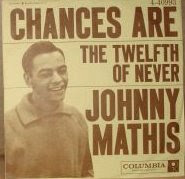 “The Twelfth of Never” is a colloquial expression referring to a hypothetical event that will never happen in the course of one’s lifetime, and one that is unlikely to occur at all. It is also the name of a frequently covered pop song that was a hit in 1957 for Johnny Mathis. Since “The Twelfth of Never” is a love song, the title refers to the moment in time when the singer will ever stop loving his beloved—in other words, never.
“The Twelfth of Never” is a colloquial expression referring to a hypothetical event that will never happen in the course of one’s lifetime, and one that is unlikely to occur at all. It is also the name of a frequently covered pop song that was a hit in 1957 for Johnny Mathis. Since “The Twelfth of Never” is a love song, the title refers to the moment in time when the singer will ever stop loving his beloved—in other words, never.
I’ll love you...Until the twelfth of Never and that’s a long, long time
Since he’ll never stop loving her, he will love her “forever.” Randy Travis sings in the song that became a No. 1 hit, “Forever And Ever, Amen,” “If you wonder how long I’ll be faithful/I’ll be happy to tell you again/I’m gonna love you forever and ever, forever and ever, amen.” As the saying goes, love, like a diamond, lasts forever (amen), except for the skeptic Arthur Lee, who perversely titled Love’s third album Forever Changes (1967), in flat contradiction to the widespread sentiment that love lasts forever, even though he often sang very much like Johnny Mathis on that album.
Thus is my preamble to a blog entry in which I originally set out to discuss songs with numbers in them, prompted by hearing Tommy Tutone’s marvelous “867-5309/Jenny” on the car radio the other day. But I discovered that at least one site has already done something like what I set out to do, so there’s really no need, as the saying goes, to reinvent the wheel. However, lists of songs with numbers in them is one thing; what they mean is, well, a horse of a different color.
There is one particular song with numbers in the title that has always especially interested me—Jimi Hendrix’s “If Six Was Nine,” on Axis: Bold as Love (1967). In 1967, when Hendrix recorded the song, he was writing within a long tradition of pop and rock songs with numbers in them—and a time about ten years after Johnny Mathis recorded “The Twelfth of Never.” Just to get a feel for the subject, I’ve listed some pop songs (including country songs) with numbers in them, in order to reveal the affinity “If Six was Nine” has with songs such as “The Twelfth of Never.” I should add that I’m reasonably confident that all of the following songs appeared before the recording of "If Six was Nine," in October 1967. The list should not be considered exhaustive by any means.
Various numbers: The Night Has a Thousand Eyes, 98.6, 19th Nervous Breakdown, Rainy Day Women #12 & 35, 1941, 18 Yellow Roses, The 59th Street Bridge Song (Feelin’ Groovy)
Highways: Route 66, Highway 61 Revisited, Highway 49
Cars: Rocket 88, 409
Girls: Sixteen Candles, You’re Sixteen, 96 Tears (note: 96=16x6)
Trains: Wreck of the Old 97
12: The Twelfth of Never
10: Ten Little Indians
9: Love Potion No. 9, Apartment No. 9, If Six was Nine
8: Eight Days a Week
7: 7 and 7 Is, 7 O’Clock News/Silent Night
6: Six O’Clock, Six O’Clock in the Morning, If Six was Nine
5: Take Five, Five O’Clock World
4: Positively 4th Street, 4th Time Around
3: Three O’Clock Rock, Wednesday Morning, 3 A.M.
2: Two Faces Have I, Just Out Of Reach (Of My Two Empty Arms), Little Deuce Coupe
1: 1-2-3, Fool #1
0: Love Minus Zero/No Limit
Mickey Newbury’s “33rd of August,” written around the same time as “If Six was Nine” (but probably after, in 1968 or '69), contains the disorientation and dislocation of songs such as “Love Potion No. 9” and “7 & 7 Is” (“I'd sit inside a bottle and pretend that I was in a can”). In these songs, number is associated with external reality, a quotidian grounding in sequential, day-to-day life, the linear world of scientific, instrumental reason. But...that dreary day-to-day reality frequently doesn’t match the internal world of the desirous imagination (or confusion, for that matter), unfettered by quotidian time. Mathematics is a matter of reason, love is a matter of desire; numbers are invoked, but they require a disinterested intellect, in contrast to what is the absolute certainty of feeling. Think of Sam Cooke’s “Wonderful World”:
Don’t know much about geography
Don’t know much trigonometry
Don’t know much about algebra
Don’t know what a slide rule is for
But I do know one and one is two,
And if this one could be with you
What a wonderful world this would be
Hence “The Twelfth of Never” points to a non-event, a moment in sequential, calendrical time that will never happen, a point in time that will never be reached. Just like the “33rd of August,” it refers to an impossible moment in time. In my view, "If Six was Nine” refers to this same impossible moment, a mathematical impossibility, the non-moment in Never when six shall be nine. For me, the song is a declaration of independence. I hear Thoreau in the song, and his statement, "If a man does not keep pace with his companions, perhaps it is because he hears a different drummer. Let him step to the music which he hears, however measured or far away."
If the sun refused to shine
I don’t mind, I don’t mind
If the mountains fell in the sea
Let it be, it ain’t me
Got my own world to live through
And I ain’t gonna copy you
Now if six turned out to be nine
I don’t mind, I don't mind
If all the hippies cut off all their hair
I don’t care, I don’t care. Dig?
‘Cause I’ve got my own world to live through
And I ain't gonna copy you
White collar conservative(s) flashin’ down the street
Pointin’ their plastic finger at me
They’re hopin’ soon my kind will drop and die
But I’m gonna wave my freak flag high. High!
Wave on, wave on
Fall mountains, just don’t fall on me
Go ahead on Mr. Businessman
You can't dress like me
[inaudible talk—see below]
Don’t nobody know what I’m talkin’ about
I’ve got my own life to live
I’m the one that’s got to die
When it’s time for me to die
So let me live my life the way I want to…
There.
Sing on brother, play on drummer
In other words, the day will never come when I'll be like you. So there.
I’ll admit my interpretation doesn’t explore the possible “occult” inferences one can find in the song, as Harry Shapiro and Caesar Glebbeek do in their book Jimi Hendrix: Electric Gypsy (St. Martin’s Griffin, 1995). I suppose my interpretation is fairly banal when compared to theirs; for instance, the reference to "Mr. Businessman" invokes, for me, anyway, the '50s novel The Man in the Gray Flannel Suit (filmed 1956), a code for the ultimate conformist, a person interested only in material acquisition. In contrast, Shapiro and Glebbeek aver that the line, “If the mountains fell in the sea,” refers to the “second world of Hopi creation mythology” (225) because Hendrix was interested in Hopi mythology (or at least read a book about it). They go on to write:
Jimi was interested in the esoteric significance of colours—the ‘vibratory’ power of colour that lies behind expressions such as ‘green with envy,’ ‘seeing red,’ and ‘feeling blue.’ As a lead-in to the last verse . . . Jimi introduces colour symbolism to reinforce the enigmatic nature of his lyrics (‘there ain’t nobody knows what I’m talkin’ about’). He speaks of ‘purple, red, yellow and green’ where (in ancient scripts) purple rays make the individual a self-ruler, red is the colour of the pioneering spirit, green is the ray of balance and harmony achieved through struggle and conflict, while yellow is the colour of creativity. The final occult inference in the song is located in the title itself: in the I Ching commentary, 6 is one of the numbers of Earth, 9 one of the numbers of Heaven.... (225-26).
I’ve never actually heard Hendrix say the four colors that Shapiro and Glebbeek refer (I can’t make out what he is saying, despite the many dozen times I've listened to the song on headphones; I do admit, however, that he is saying something), but I’ll take their word for it. Most certainly colors--in the sense of one's "true colors"--are invoked by his reference to "flag," which carries one's "standard" in a military sense, or identifying colors. "Freak flag," of course, suggests unusual colors, or perhaps even black, as in skin color. And if--as Shapiro and Glebbeek claim--in the I Ching, 6 is indeed one of the numbers of Earth and 9 one of the numbers of Heaven, then the idea of the two places ever possibly being the same names an impossible moment in time--just like "the twelfth of never."


